
Art and Craft
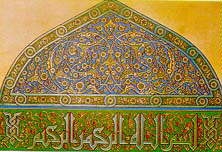 The Muslims rulers of
India, specially the Moguls have left very deep impact on the art and craft of
the subcontinent, and surely Pakistan is its rightful beneficiary. Be it music,
craftsmanship, architecture, literature (specially poetry), all branches of art
and craft have been greatly influenced by the Arabs, Persians, Turks and lately
the Moguls. Although, the impact of Victorian and western styles due to the 100
years British rule in India has left some imprints, one is still spellbound and
fascinated by the impact the Muslims.
The Muslims rulers of
India, specially the Moguls have left very deep impact on the art and craft of
the subcontinent, and surely Pakistan is its rightful beneficiary. Be it music,
craftsmanship, architecture, literature (specially poetry), all branches of art
and craft have been greatly influenced by the Arabs, Persians, Turks and lately
the Moguls. Although, the impact of Victorian and western styles due to the 100
years British rule in India has left some imprints, one is still spellbound and
fascinated by the impact the Muslims.
|
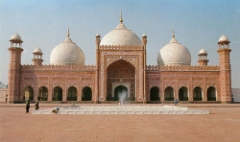 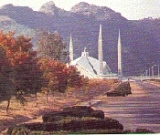 The
Islamic art
mainly focuses on geometric patterns and designs, which is considered to be one of the most complex in the world. Using red and white stones and marbles, infusing Persian mosaic in addition to symmetry in designs grace mosques and the ancient palaces of the Mogul Era.
Pakistani architecture is still under the influence of the Mogul architecture, with its delicate and sophisticated motifs and designs,
skilfully blending it with modern western architecture. The Badshahi Mosque (far left) in Lahore and Faisal Mosque (left) in Islamabad are two examples of old
Mogul and new forms of
architecture, both of which are places worth visiting and admiring. The
Islamic art
mainly focuses on geometric patterns and designs, which is considered to be one of the most complex in the world. Using red and white stones and marbles, infusing Persian mosaic in addition to symmetry in designs grace mosques and the ancient palaces of the Mogul Era.
Pakistani architecture is still under the influence of the Mogul architecture, with its delicate and sophisticated motifs and designs,
skilfully blending it with modern western architecture. The Badshahi Mosque (far left) in Lahore and Faisal Mosque (left) in Islamabad are two examples of old
Mogul and new forms of
architecture, both of which are places worth visiting and admiring.
Another major effect of Islamic art can be seen in the field of
Calligraphy. The Islamic injunction against representation of animate objects chanelized the Muslim aesthetic spirits into
calligraphy, mostly drawn from the Koran and then embellished with elaborate designs. Although, various forms of lettering styles had been in vogue for expression,
Sadequain is considered to be the pioneer in introducing his own style of Islamic calligraphy, which not only gives him distinction over all of his contemporaries, but also injected a new spirit among many a new young men to come up with new styles to in Islamic calligraphy. However, despite the fact, many who followed the footsteps of Sadequain, but none could match his maestro.
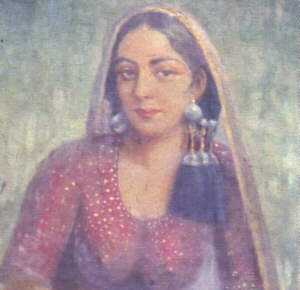

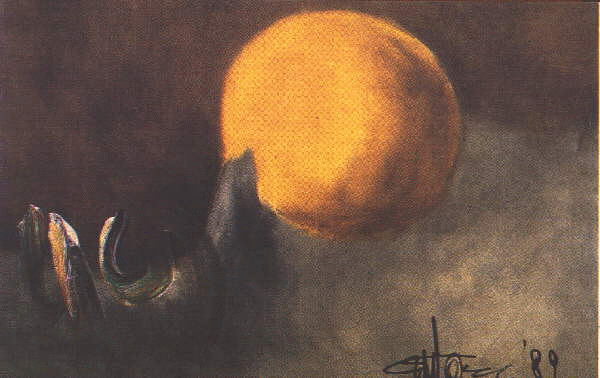
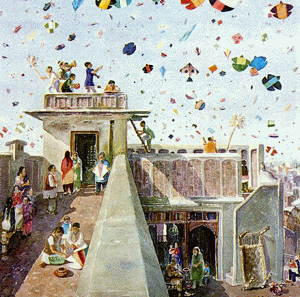
Paintings
have a mixed influence of modern and indigenous style. From
Ustad Allah Bakhsh's landscapes to
Chughtai's marvelous water colours, and from large murals of Sadequain to
Guljee the canvases are full of hues and deep impacting landscapes reflecting life and culture of Pakistan.
Many other names like that of Anna Molka Ahmed, Shakir Ali, Anwar Kamal, Jameel Naqash, Nagi and Mehdi appear with recognition when one explores the world of paintings. Many a art galleries have been established in all major cities of Pakistan where
armatures and professionals display their art work and receive appreciation. |
Craft and Craftsmanship: While the modern architecture and music thrives in the cities and
urban areas, the artisans and craftsmen continue to produce marvels in their own way that are attractive and
eye-catching.
Each region in Pakistan has its own specialty and if given a choice, it really become an up hill task to choose from a wide variety.
About 55 km from Hyderabad and 5 km from Bhit Shah is Hala, which is famous for its blue lined white ceramics besides pottery vases, birds & tiles, lacquer work chairs, beds and cots and wood carvings.
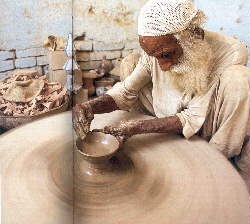


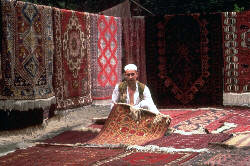
The
Bhong Mosque in Rahim Yar Khan boasts an extraordinary modern architecture and interior (winner of the Aga Khan Award for Architecture). It is built in traditional style with extravagant use of gold leaf, mirror work and onyx; it is particularly famous for its stylized Arabic calligraphy. Like Hala in Sind, Multan in
Southern Punjab is also famous for its blue pottery, extensive stitch work for women dresses and camel skin lamps, hand loom fabrics. The Balochistan province, specially Quetta, Kharan and Kalat are famous for hand woven carpets, while NWFP, specially Chitral, Abottabad are famous for wool and woolen cloth. Punjab is famous for bed Sheets, Duries and Khes (Gakkhar), pottery (Gujranwala), brass (Lahore), cotton and
hand-woven fabrics (Faisalabad), walnut furniture (Chiniot).
Another interesting form of very indigenous art is found on buses and trucks in Pakistan, using
in numerous colours the road side
artists decorate the buses and trucks drawing birds, animals, rural landscapes or even some celebrities.
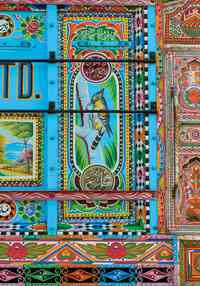
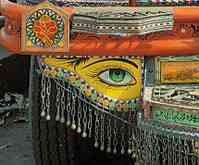
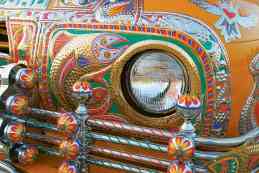
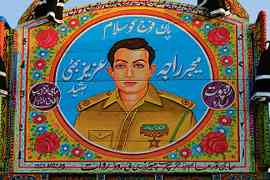
|
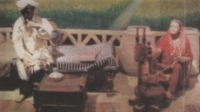 In order to conserve our folk heritage "Lok Virsa" or the
National Institute of Folk and Traditional Heritage
In order to conserve our folk heritage "Lok Virsa" or the
National Institute of Folk and Traditional Heritage
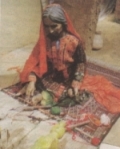 was established in 1974 by the Government of Pakistan in Islamabad under the foothills of the "Shakarparrian Hills" near the Rose and Jasmine Garden.
The Institute is member of the UNESCO, International Council of the Music, the Asian Cultural Centre for UNESCO and International Council of Museums. The
basic purpose of the Institute is to find all artisans, craftsmen and even those who wish to contribute to the preservation of our folk heritage and provide them a platform to express themselves aesthetically. Spread over some 60,000 square feet, the various sections represent each region / province of the country through paintings, models, sculptures and books.
The National Fund for Cultural Heritage is yet another effort to preserve the
national treasure, lest it is lost for future generations. Read More......
was established in 1974 by the Government of Pakistan in Islamabad under the foothills of the "Shakarparrian Hills" near the Rose and Jasmine Garden.
The Institute is member of the UNESCO, International Council of the Music, the Asian Cultural Centre for UNESCO and International Council of Museums. The
basic purpose of the Institute is to find all artisans, craftsmen and even those who wish to contribute to the preservation of our folk heritage and provide them a platform to express themselves aesthetically. Spread over some 60,000 square feet, the various sections represent each region / province of the country through paintings, models, sculptures and books.
The National Fund for Cultural Heritage is yet another effort to preserve the
national treasure, lest it is lost for future generations. Read More......
 |
| HOME PAGE |
This page was created on 1 January 2005 /
 8 March 2007
8 March 2007

Copyright©JalalsPages - 2005
- 2007
|
 The Muslims rulers of
India, specially the Moguls have left very deep impact on the art and craft of
the subcontinent, and surely Pakistan is its rightful beneficiary. Be it music,
craftsmanship, architecture, literature (specially poetry), all branches of art
and craft have been greatly influenced by the Arabs, Persians, Turks and lately
the Moguls. Although, the impact of Victorian and western styles due to the 100
years British rule in India has left some imprints, one is still spellbound and
fascinated by the impact the Muslims.
The Muslims rulers of
India, specially the Moguls have left very deep impact on the art and craft of
the subcontinent, and surely Pakistan is its rightful beneficiary. Be it music,
craftsmanship, architecture, literature (specially poetry), all branches of art
and craft have been greatly influenced by the Arabs, Persians, Turks and lately
the Moguls. Although, the impact of Victorian and western styles due to the 100
years British rule in India has left some imprints, one is still spellbound and
fascinated by the impact the Muslims.

 The
Islamic art
mainly focuses on geometric patterns and designs, which is considered to be one of the most complex in the world. Using red and white stones and marbles, infusing Persian mosaic in addition to symmetry in designs grace mosques and the ancient palaces of the Mogul Era.
Pakistani architecture is still under the influence of the Mogul architecture, with its delicate and sophisticated motifs and designs,
skilfully blending it with modern western architecture. The Badshahi Mosque (far left) in Lahore and Faisal Mosque (left) in Islamabad are two examples of old
Mogul and new forms of
architecture, both of which are places worth visiting and admiring.
The
Islamic art
mainly focuses on geometric patterns and designs, which is considered to be one of the most complex in the world. Using red and white stones and marbles, infusing Persian mosaic in addition to symmetry in designs grace mosques and the ancient palaces of the Mogul Era.
Pakistani architecture is still under the influence of the Mogul architecture, with its delicate and sophisticated motifs and designs,
skilfully blending it with modern western architecture. The Badshahi Mosque (far left) in Lahore and Faisal Mosque (left) in Islamabad are two examples of old
Mogul and new forms of
architecture, both of which are places worth visiting and admiring.












 In order to conserve our folk heritage "Lok Virsa" or the
National Institute of Folk and Traditional Heritage
In order to conserve our folk heritage "Lok Virsa" or the
National Institute of Folk and Traditional Heritage
 was established in 1974 by the Government of Pakistan in Islamabad under the foothills of the "Shakarparrian Hills" near the Rose and Jasmine Garden.
The Institute is member of the UNESCO, International Council of the Music, the Asian Cultural Centre for UNESCO and International Council of Museums. The
basic purpose of the Institute is to find all artisans, craftsmen and even those who wish to contribute to the preservation of our folk heritage and provide them a platform to express themselves aesthetically. Spread over some 60,000 square feet, the various sections represent each region / province of the country through paintings, models, sculptures and books.
The National Fund for Cultural Heritage is yet another effort to preserve the
national treasure, lest it is lost for future generations. Read More......
was established in 1974 by the Government of Pakistan in Islamabad under the foothills of the "Shakarparrian Hills" near the Rose and Jasmine Garden.
The Institute is member of the UNESCO, International Council of the Music, the Asian Cultural Centre for UNESCO and International Council of Museums. The
basic purpose of the Institute is to find all artisans, craftsmen and even those who wish to contribute to the preservation of our folk heritage and provide them a platform to express themselves aesthetically. Spread over some 60,000 square feet, the various sections represent each region / province of the country through paintings, models, sculptures and books.
The National Fund for Cultural Heritage is yet another effort to preserve the
national treasure, lest it is lost for future generations. Read More......